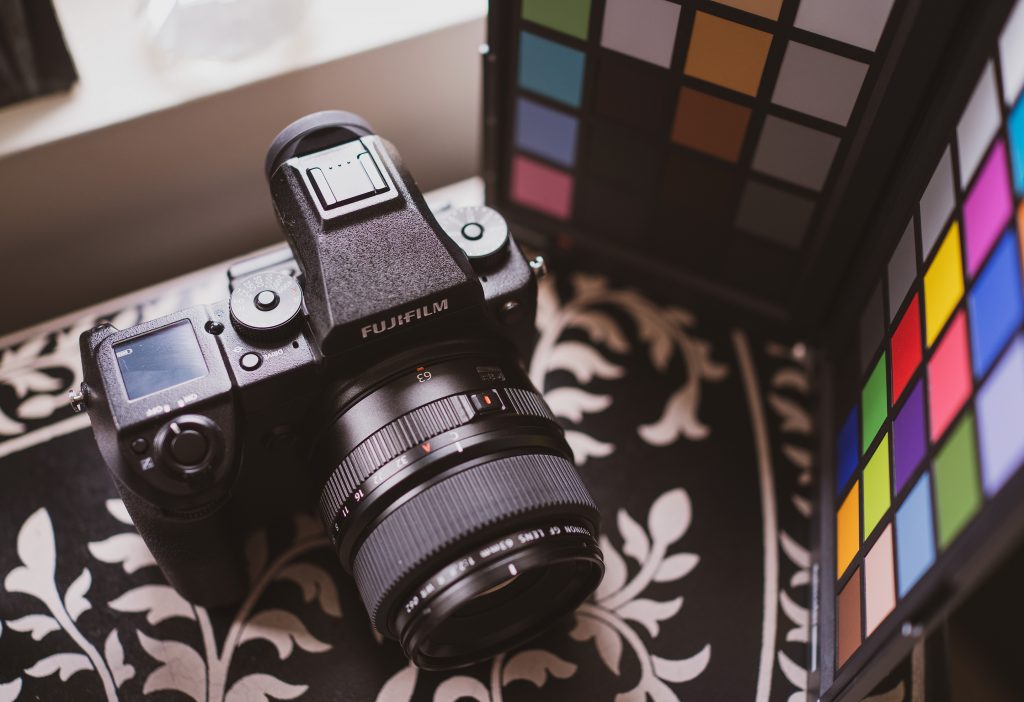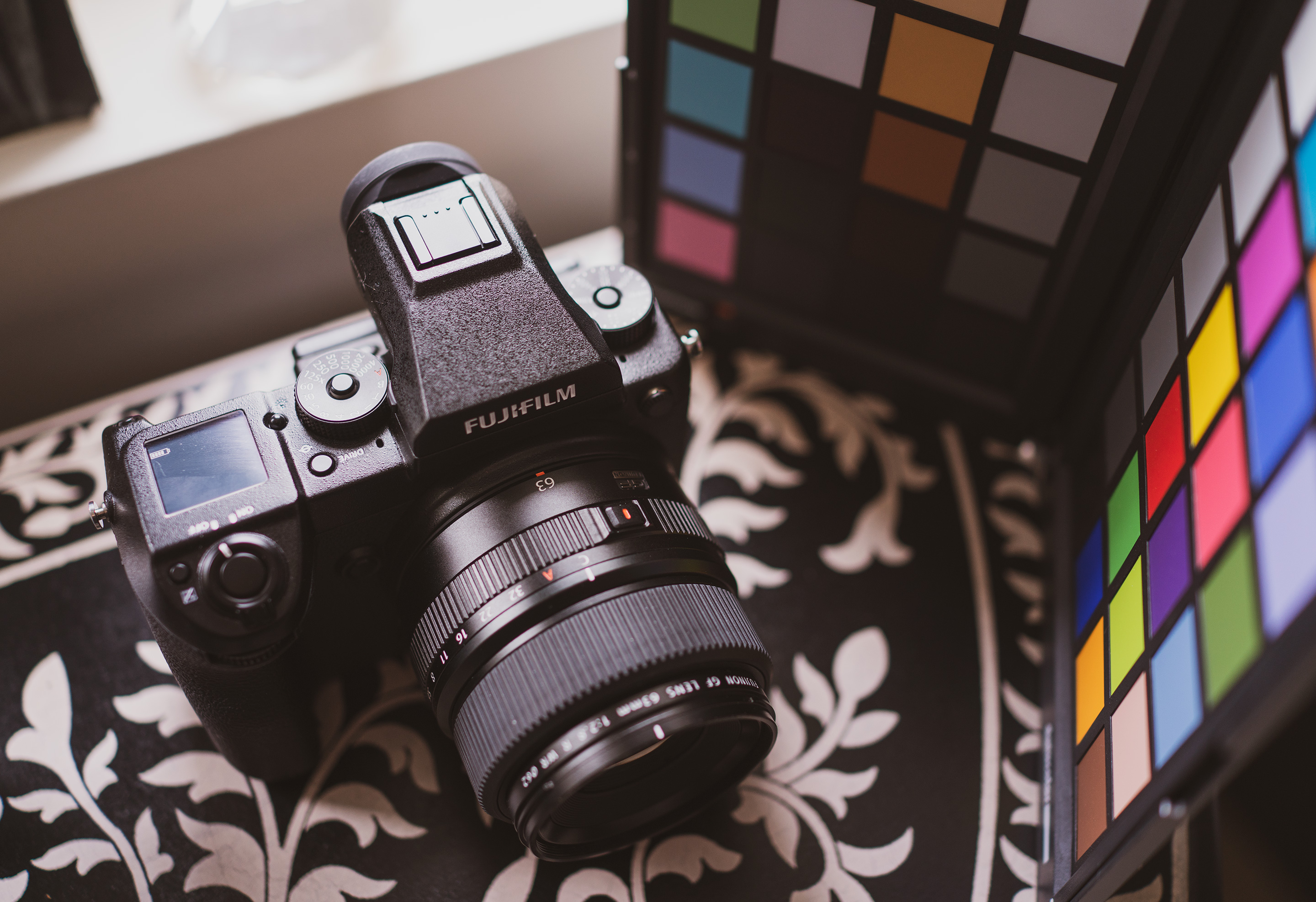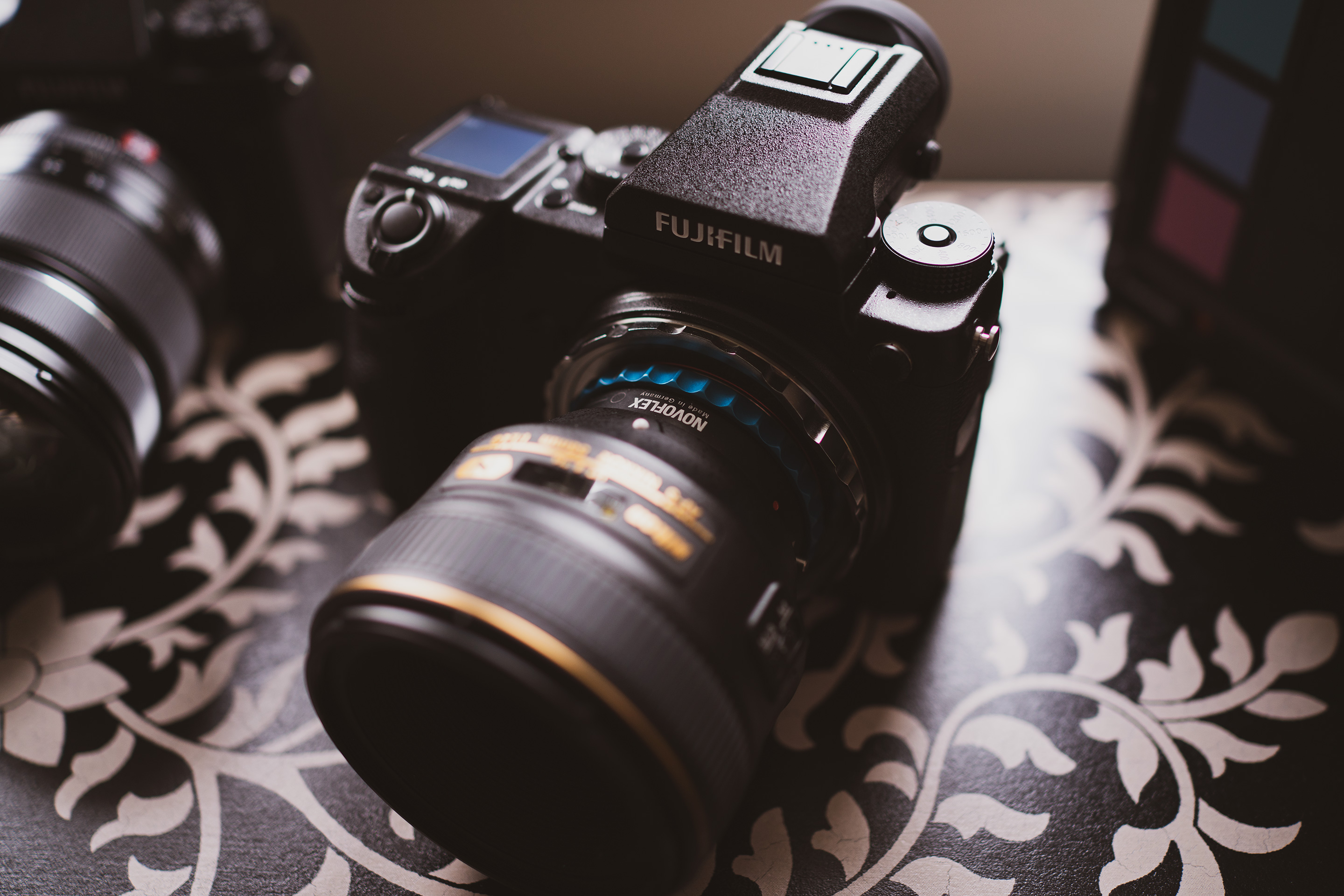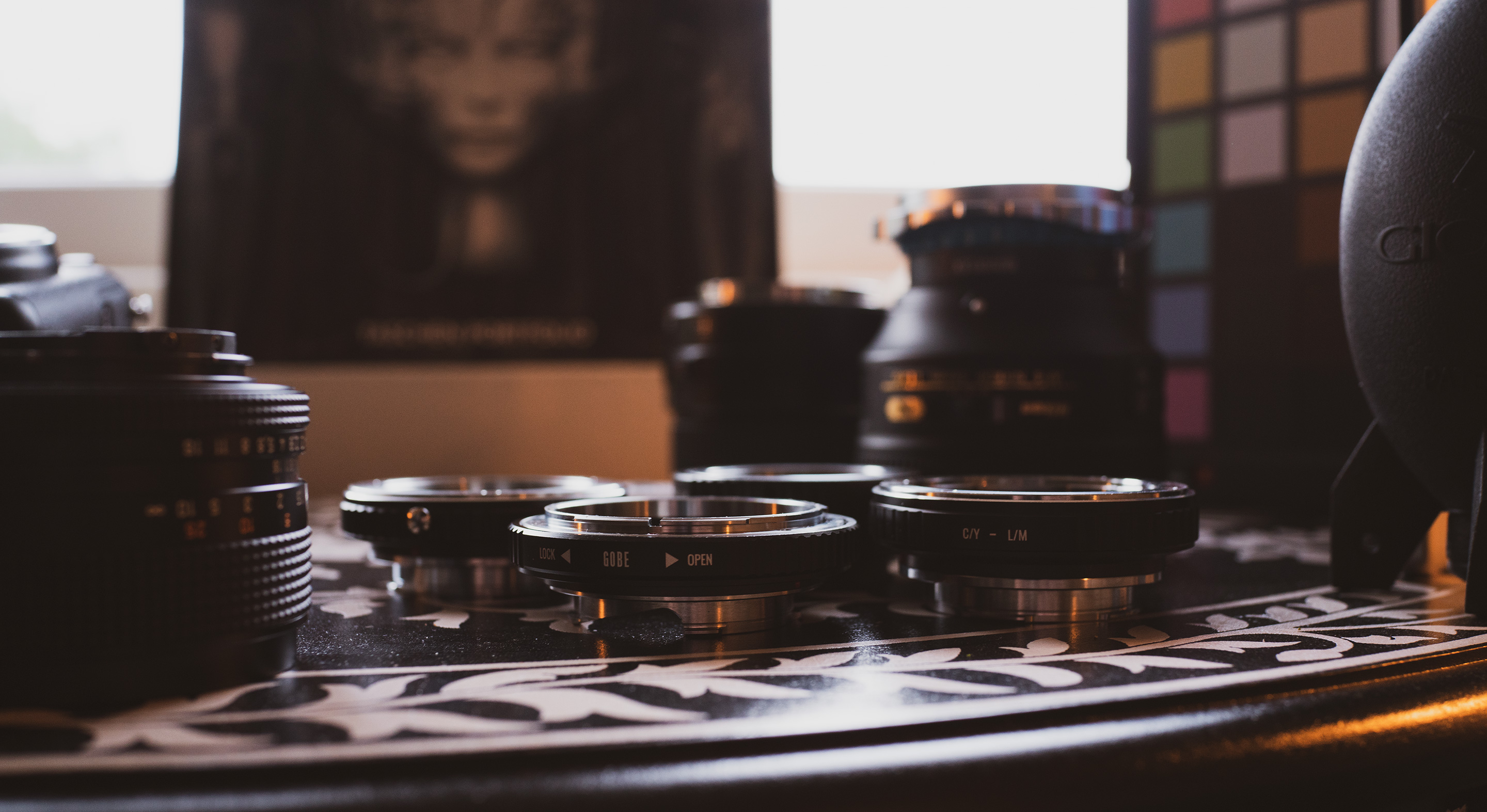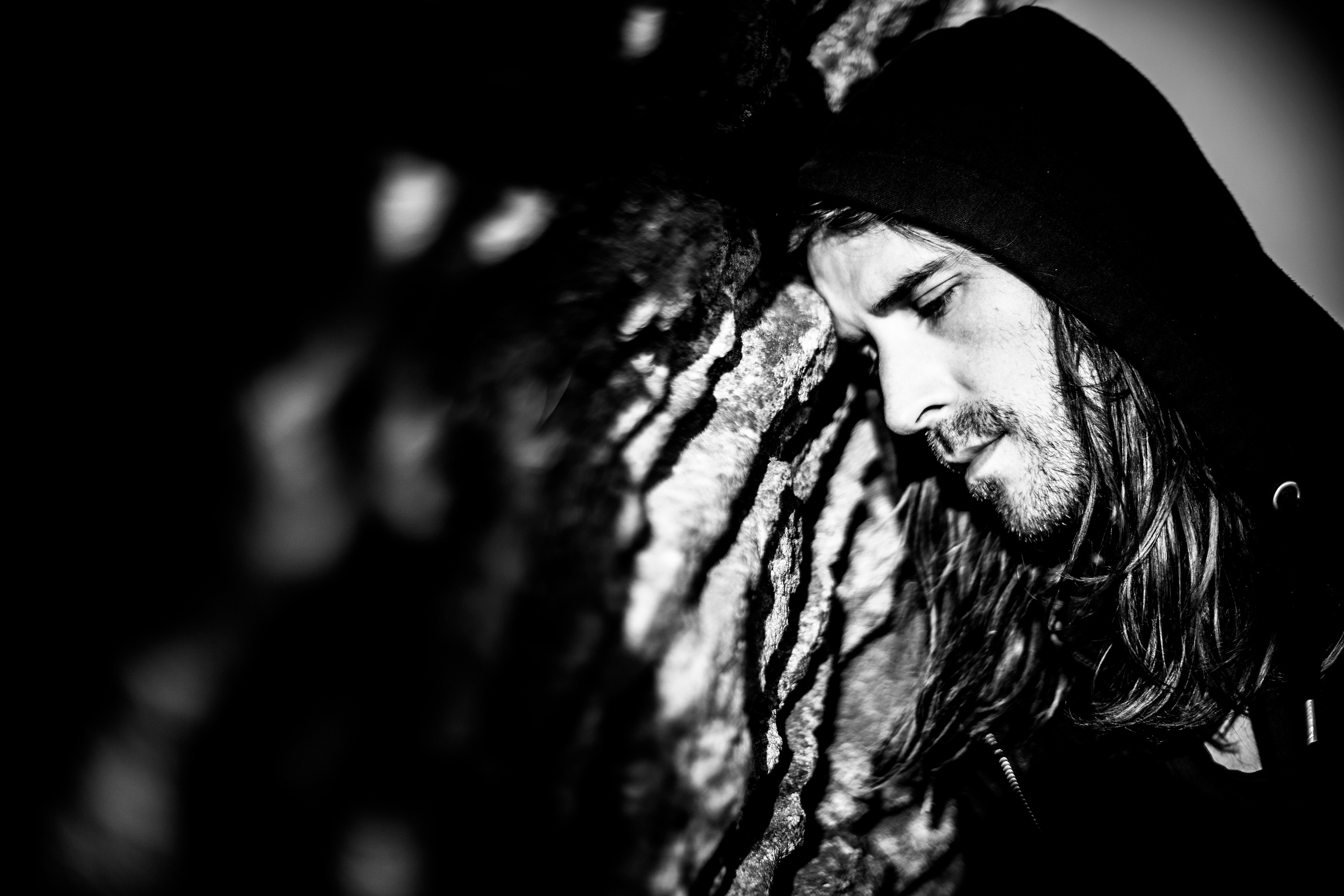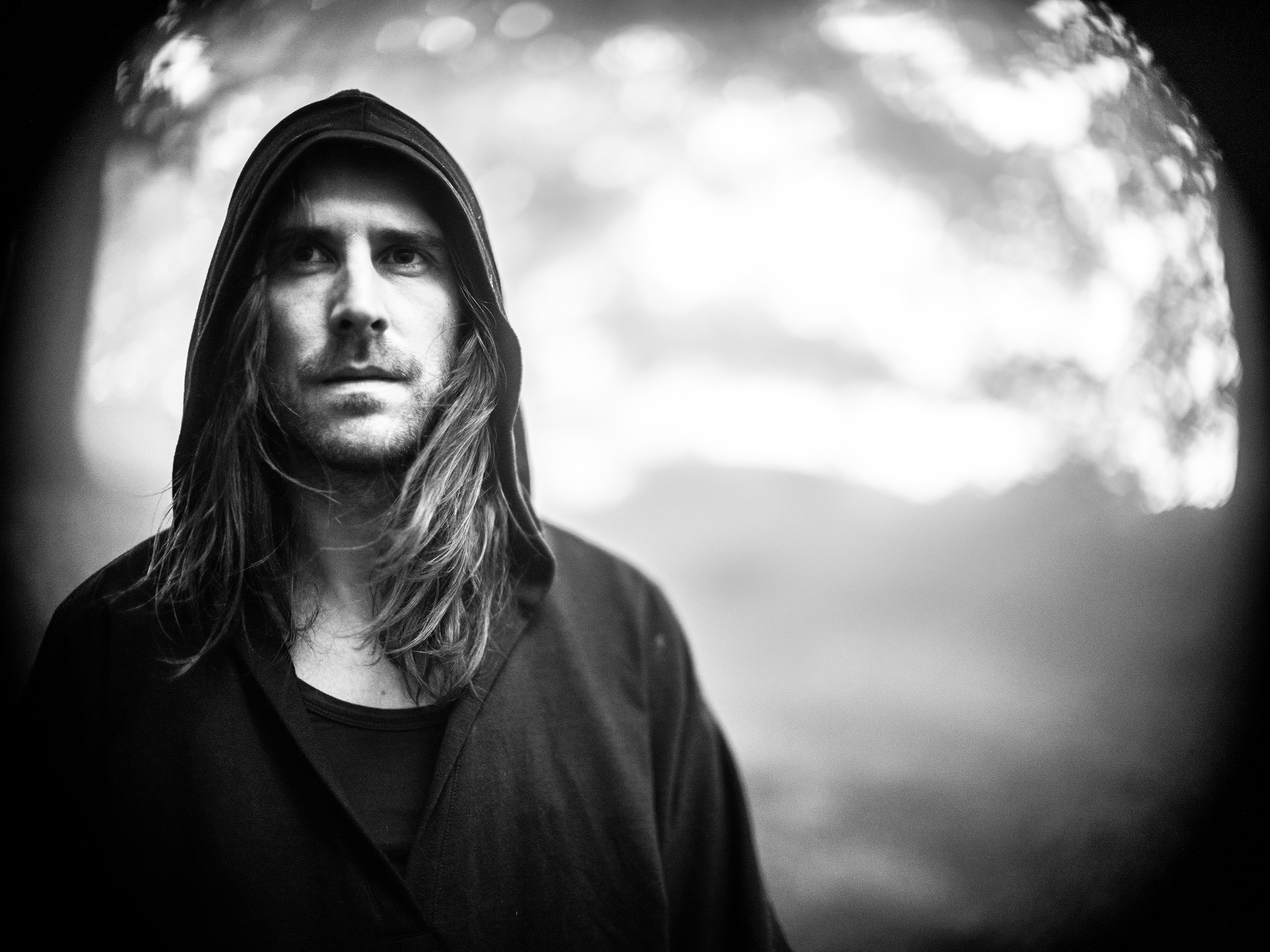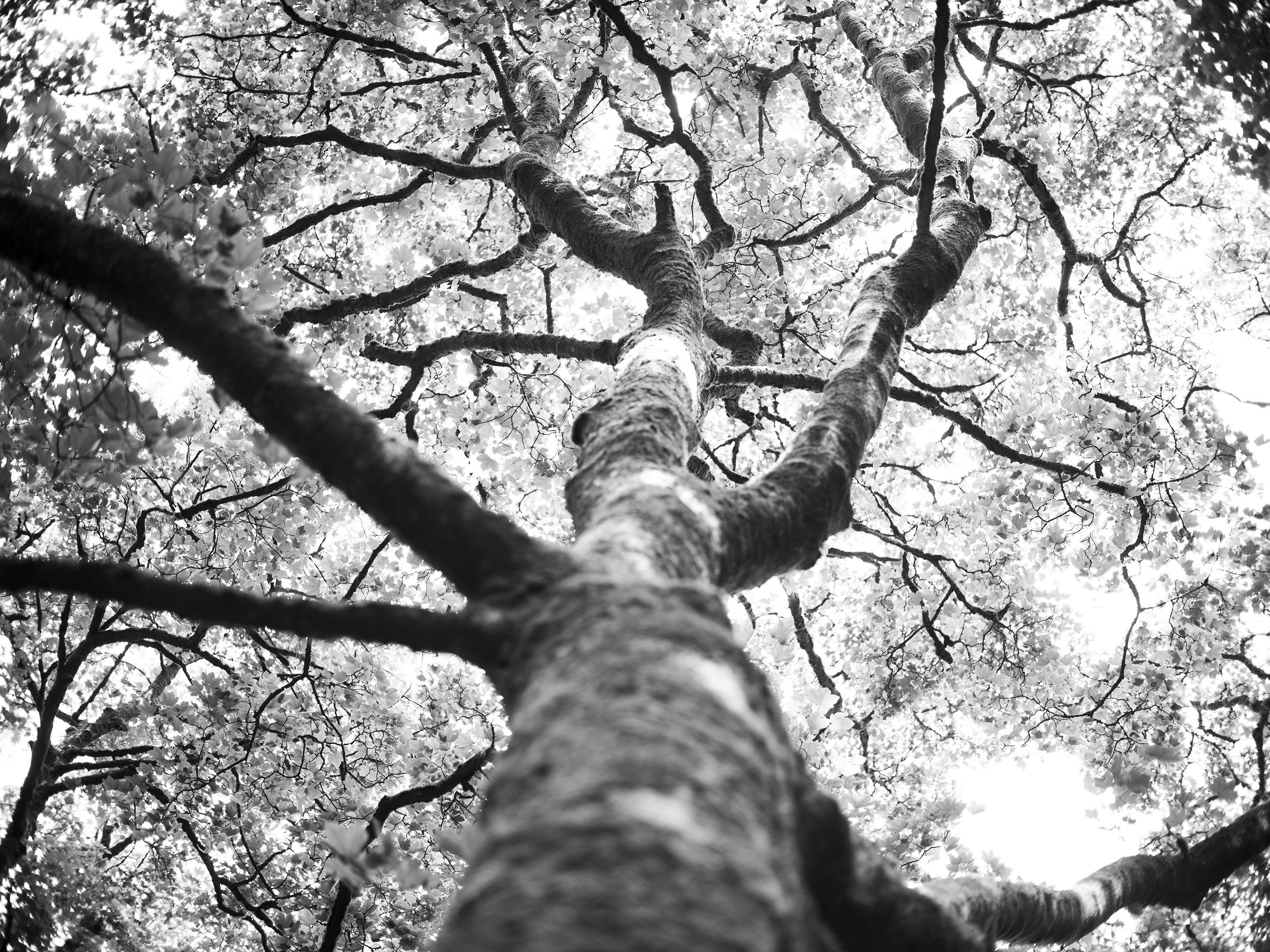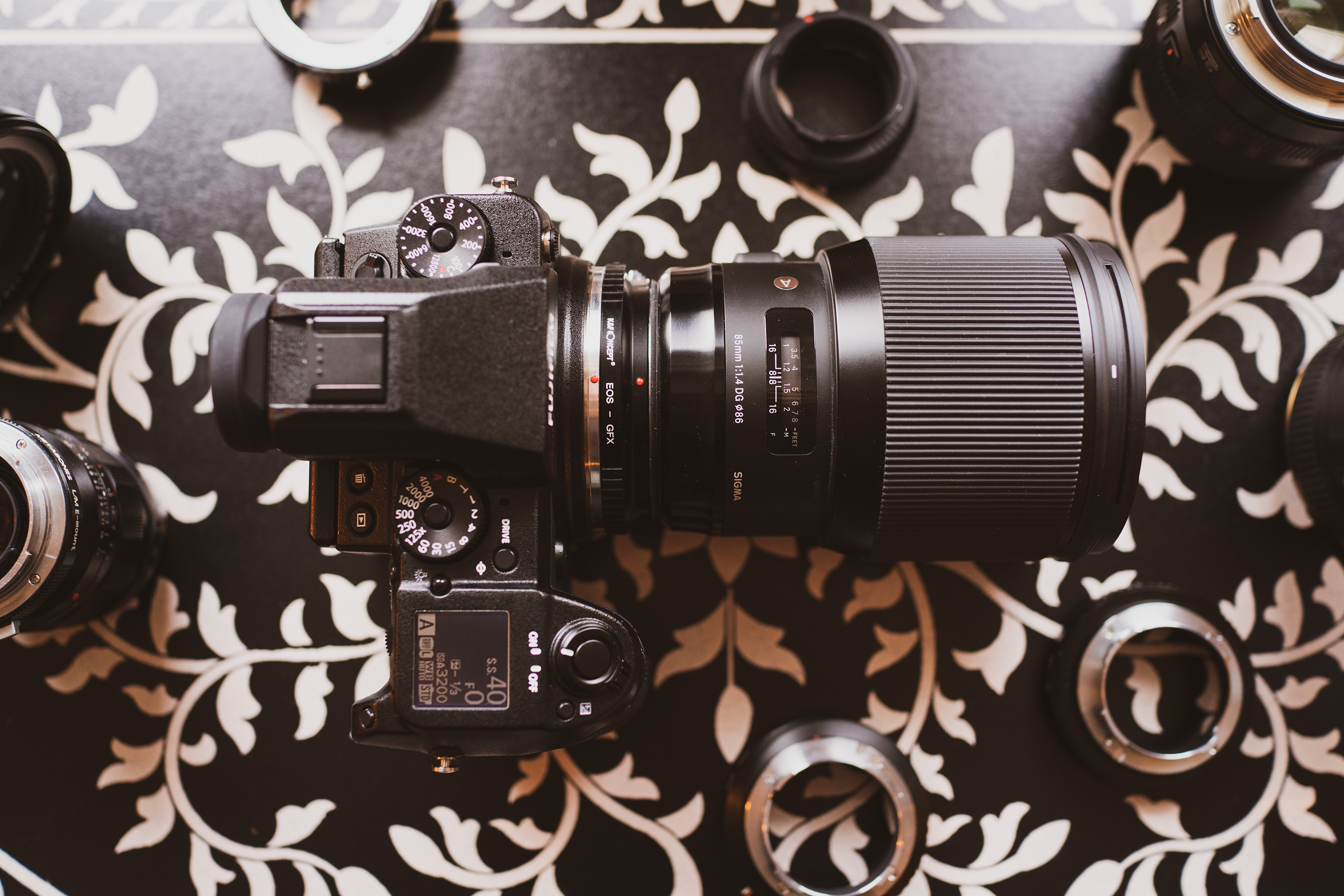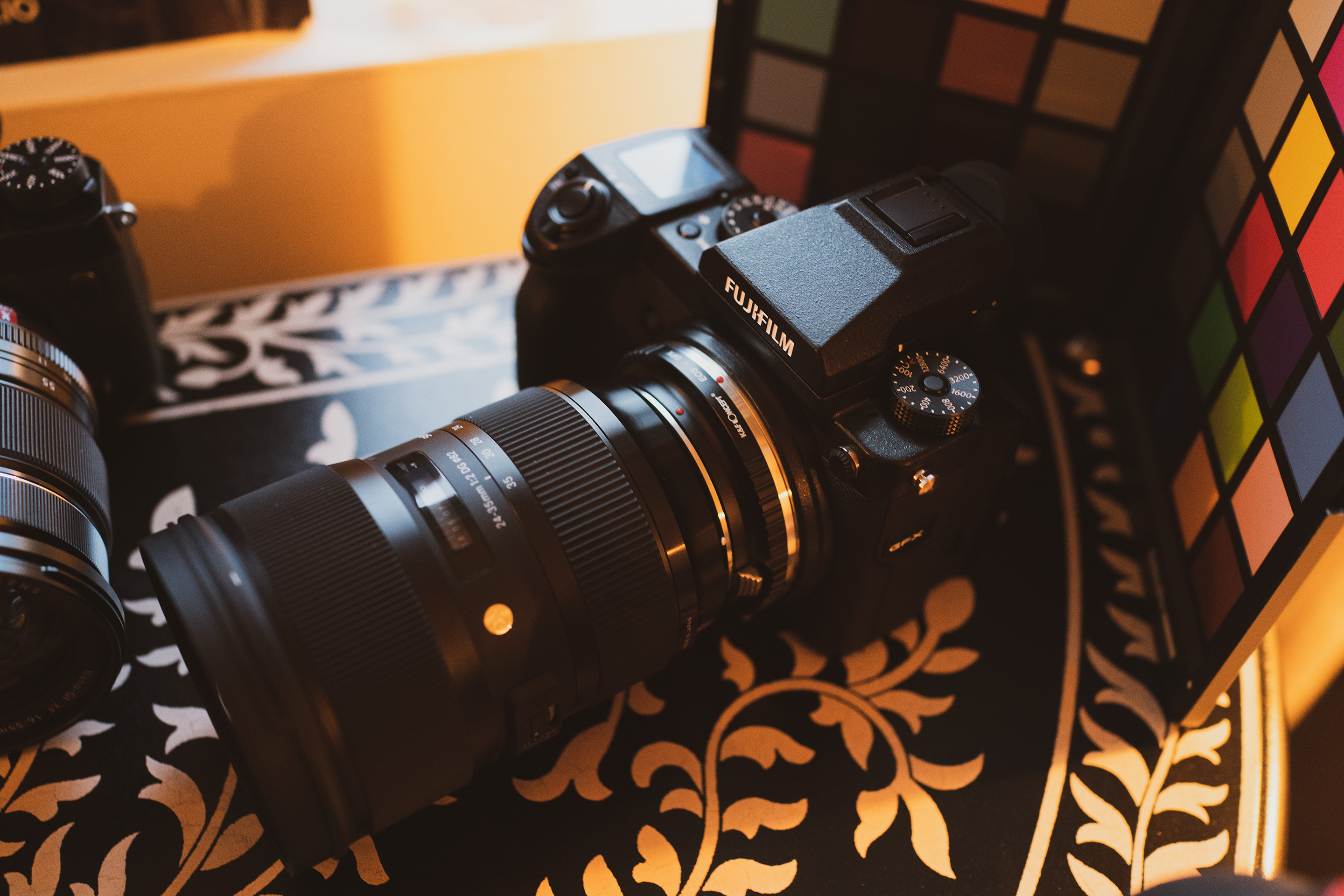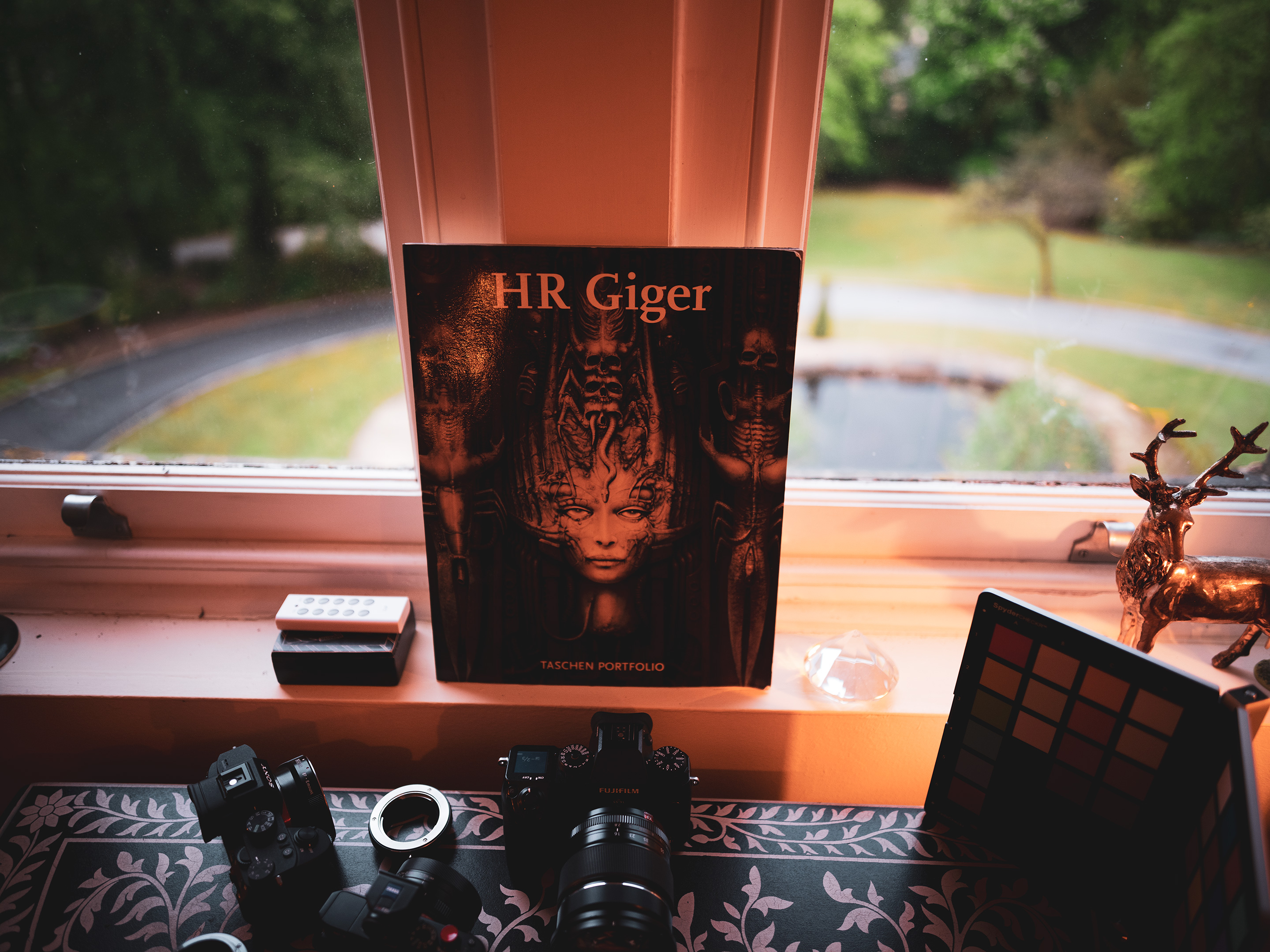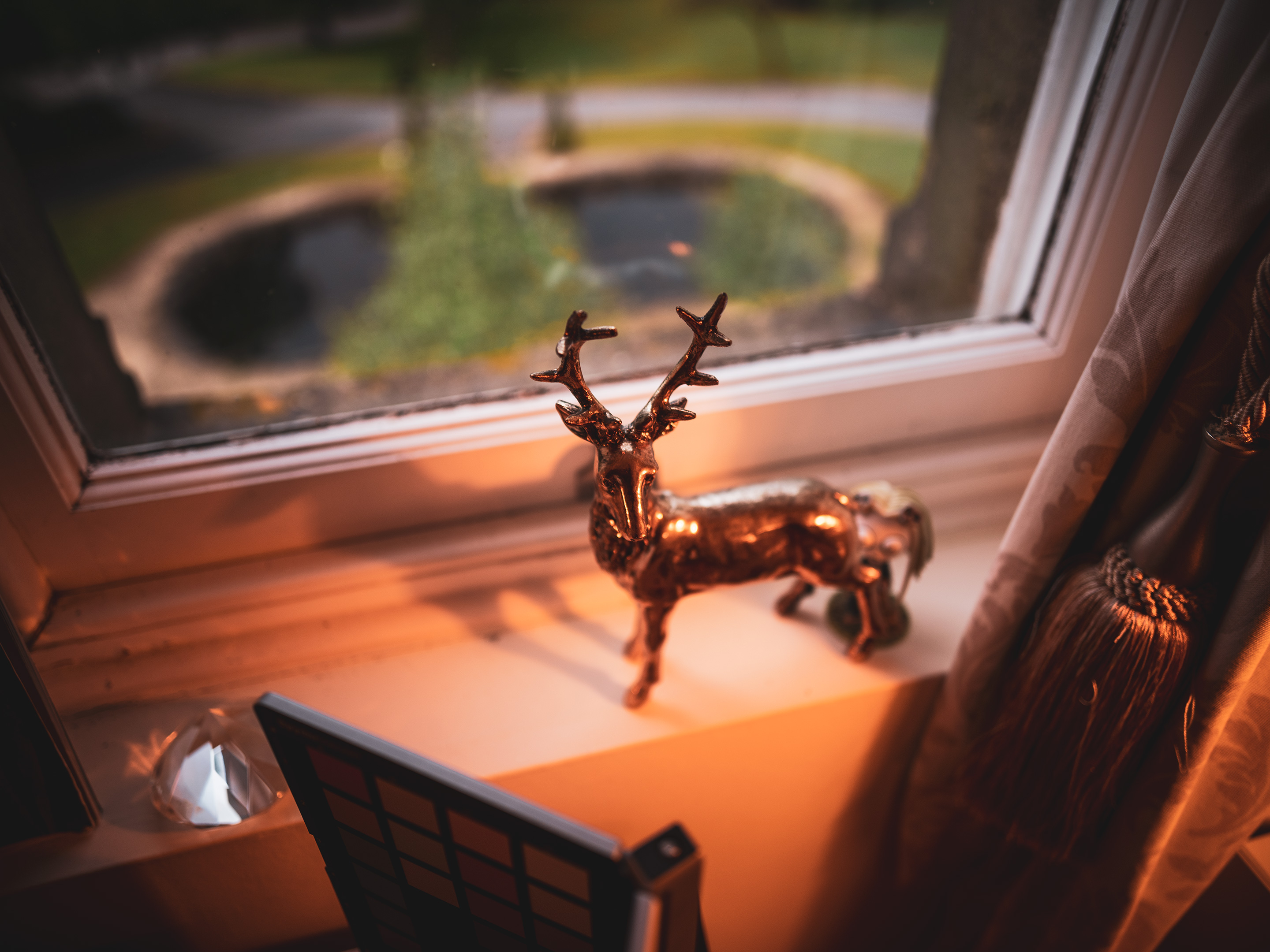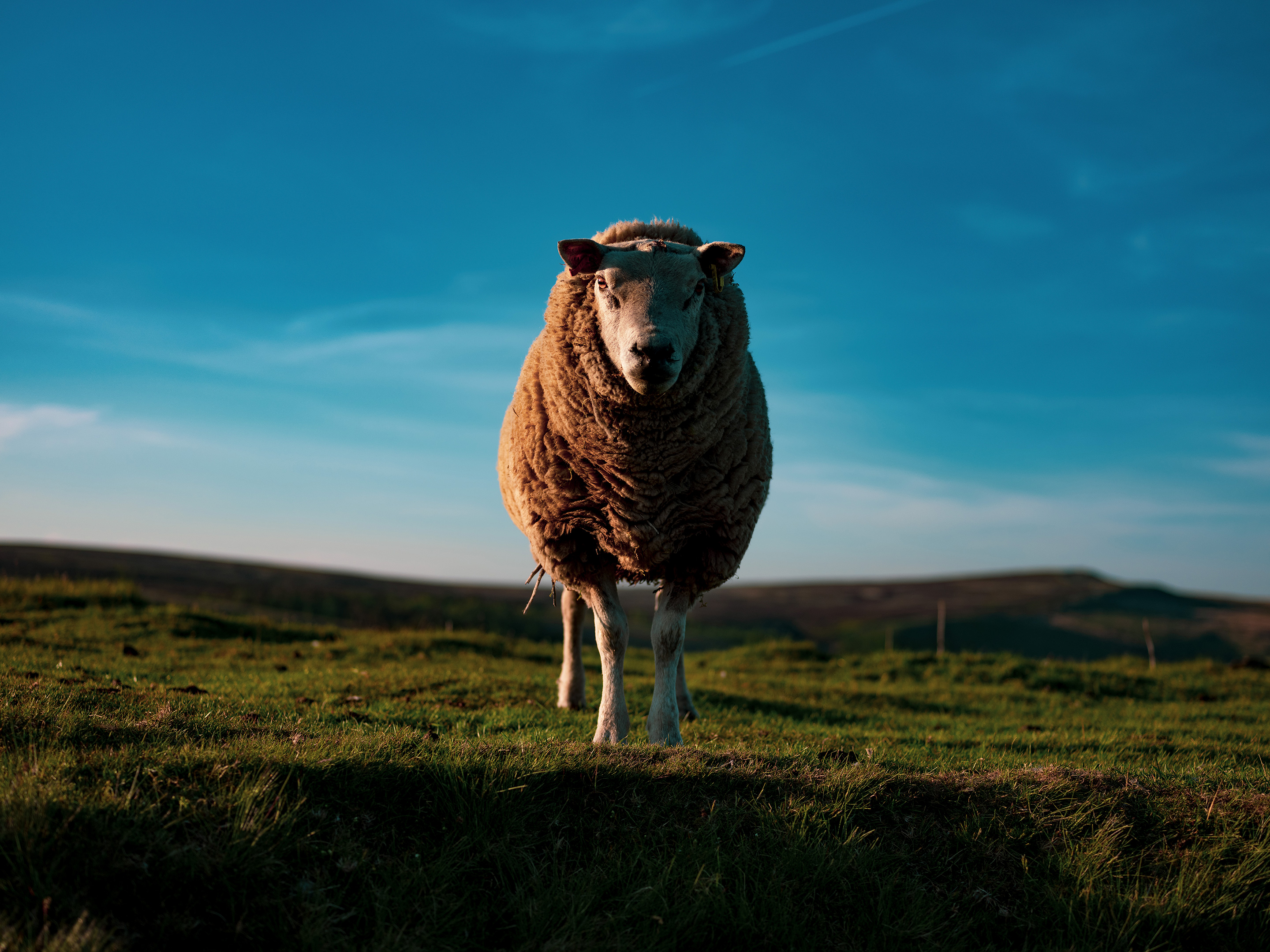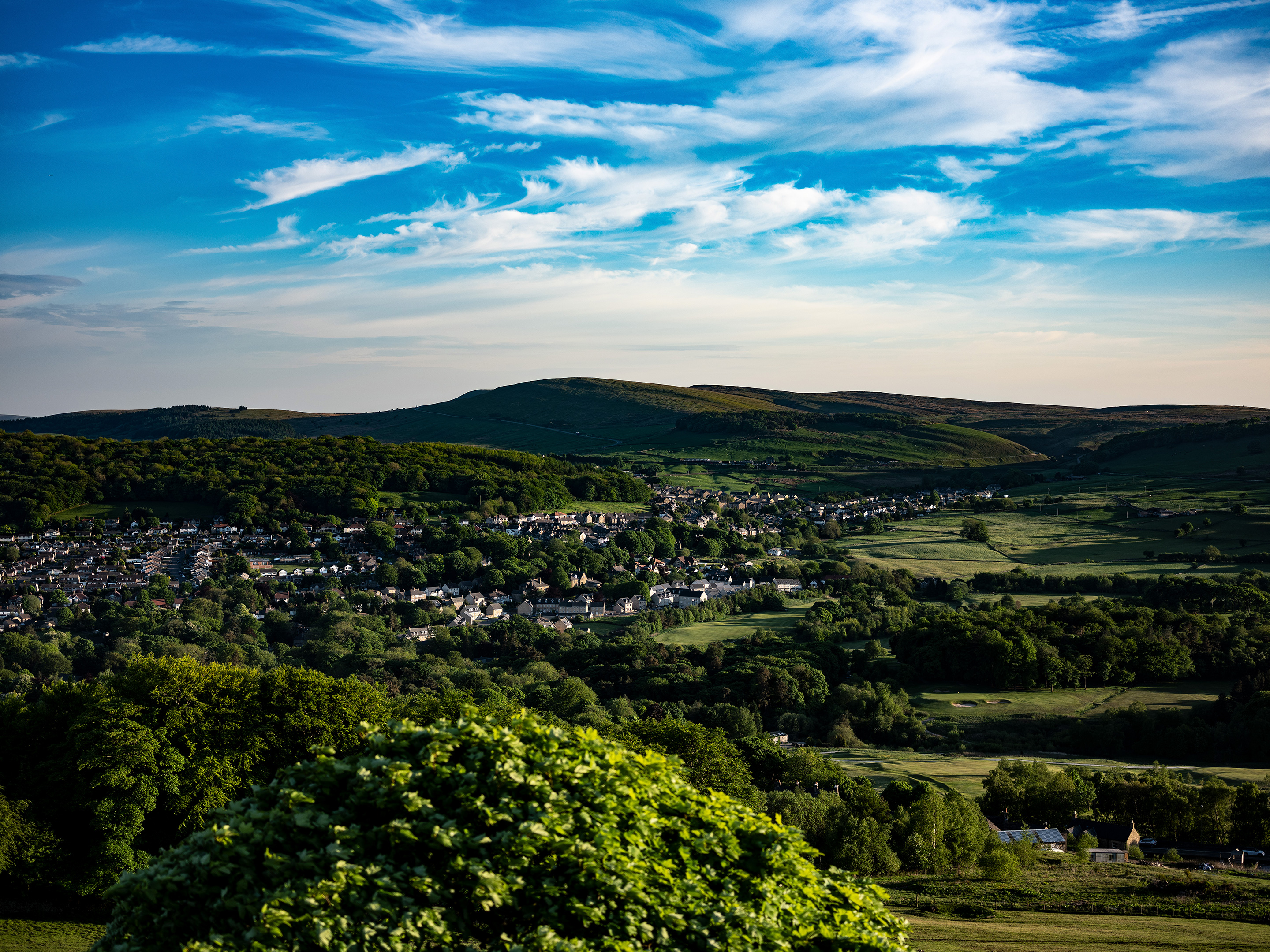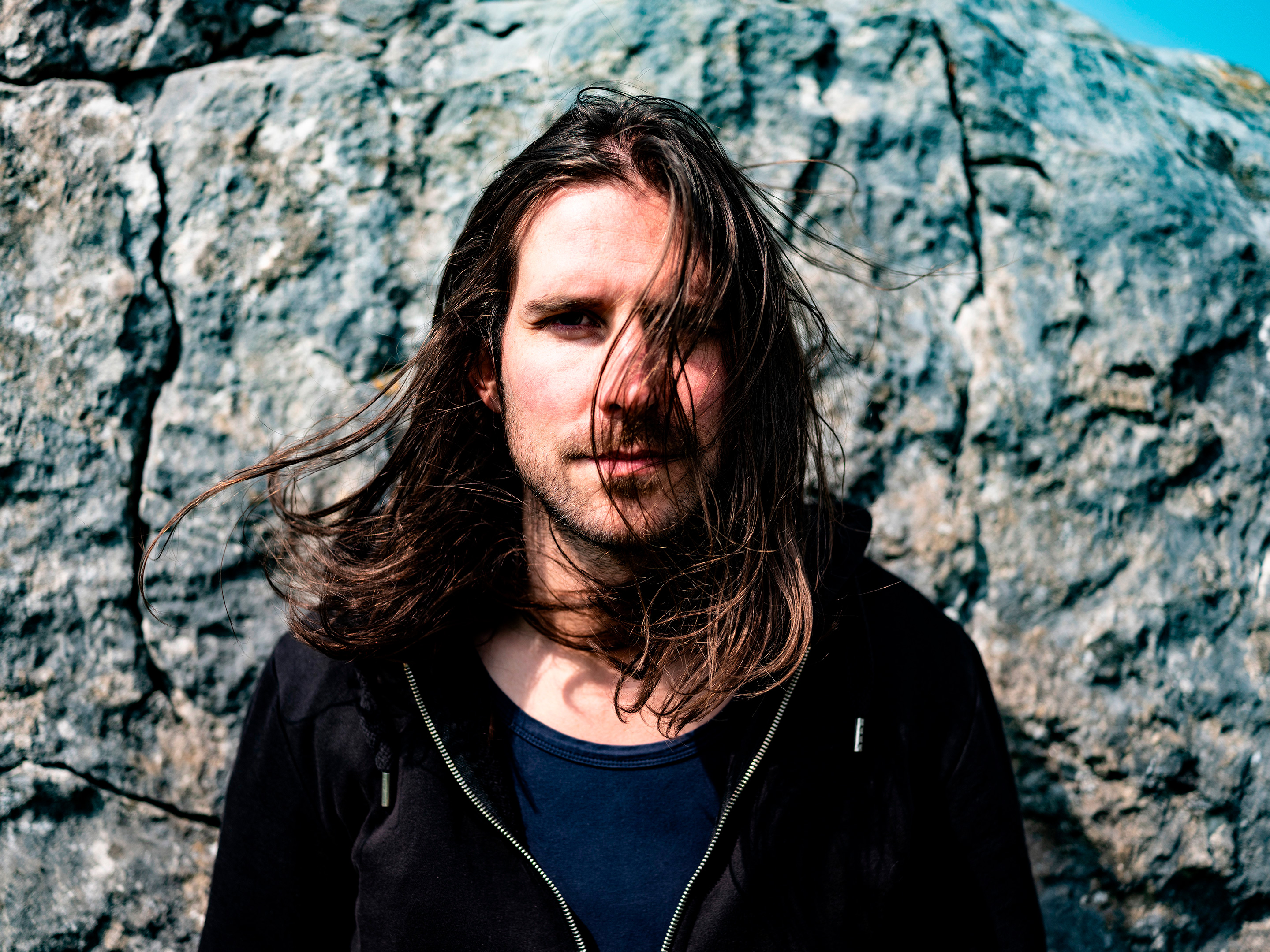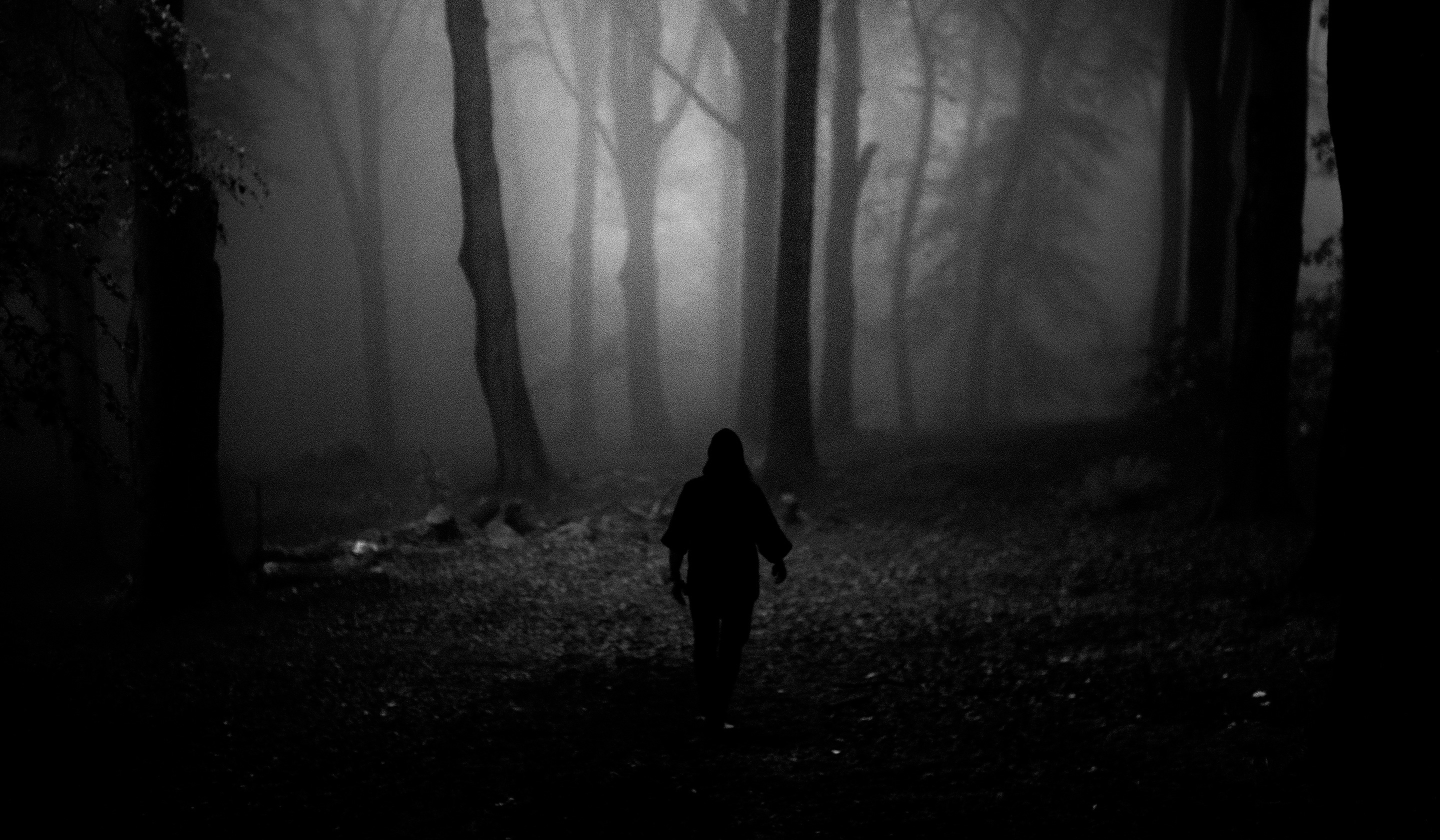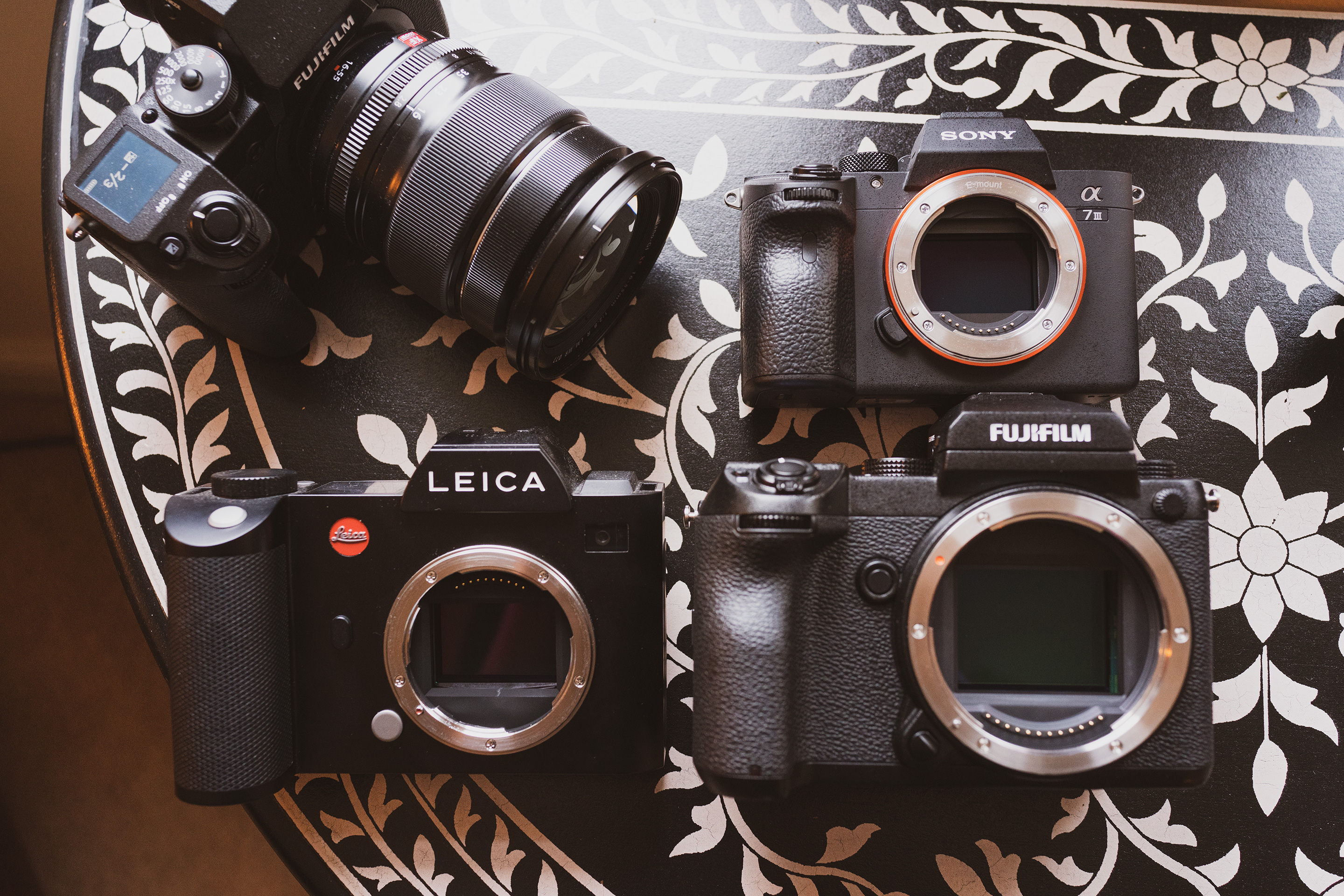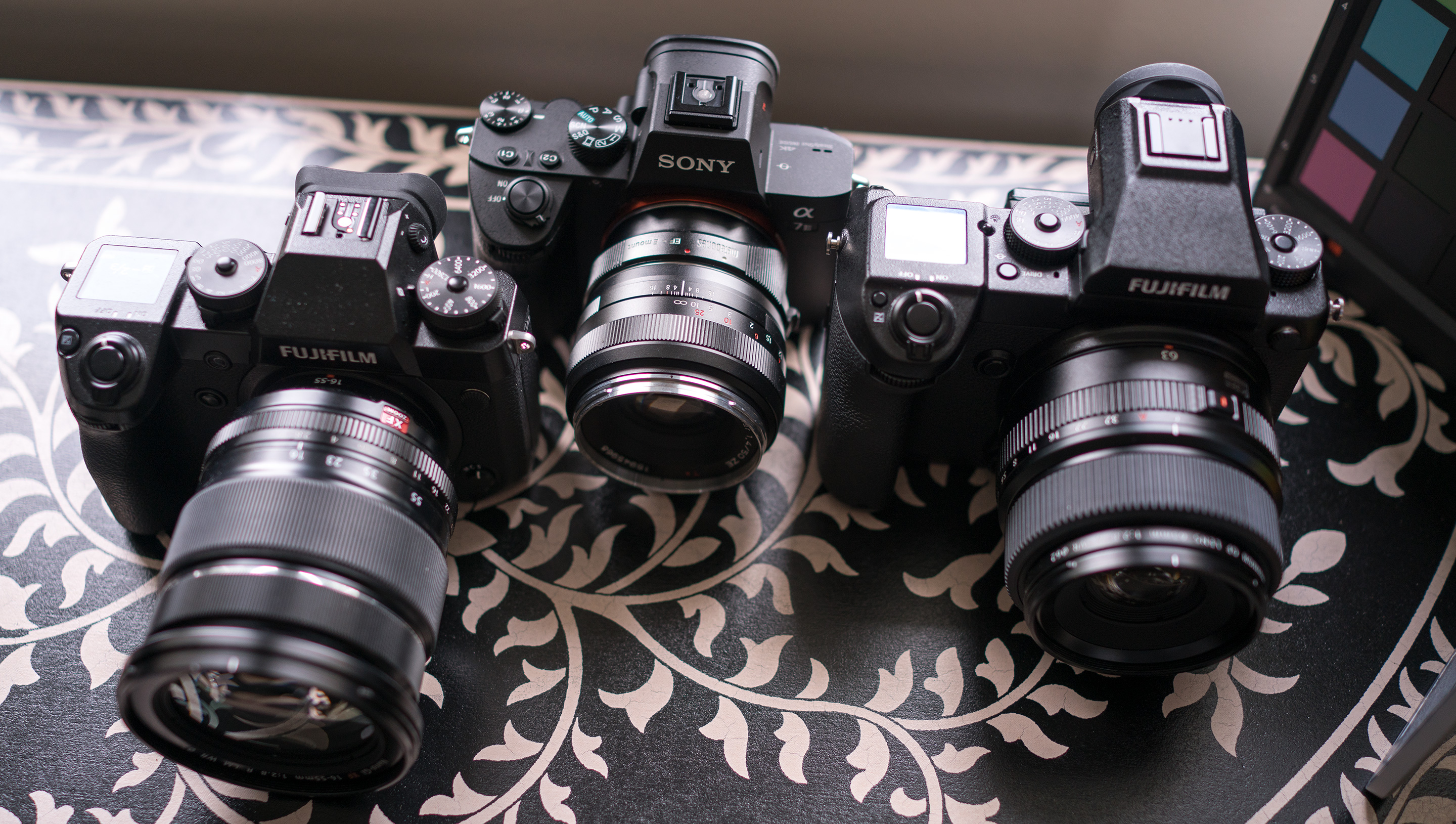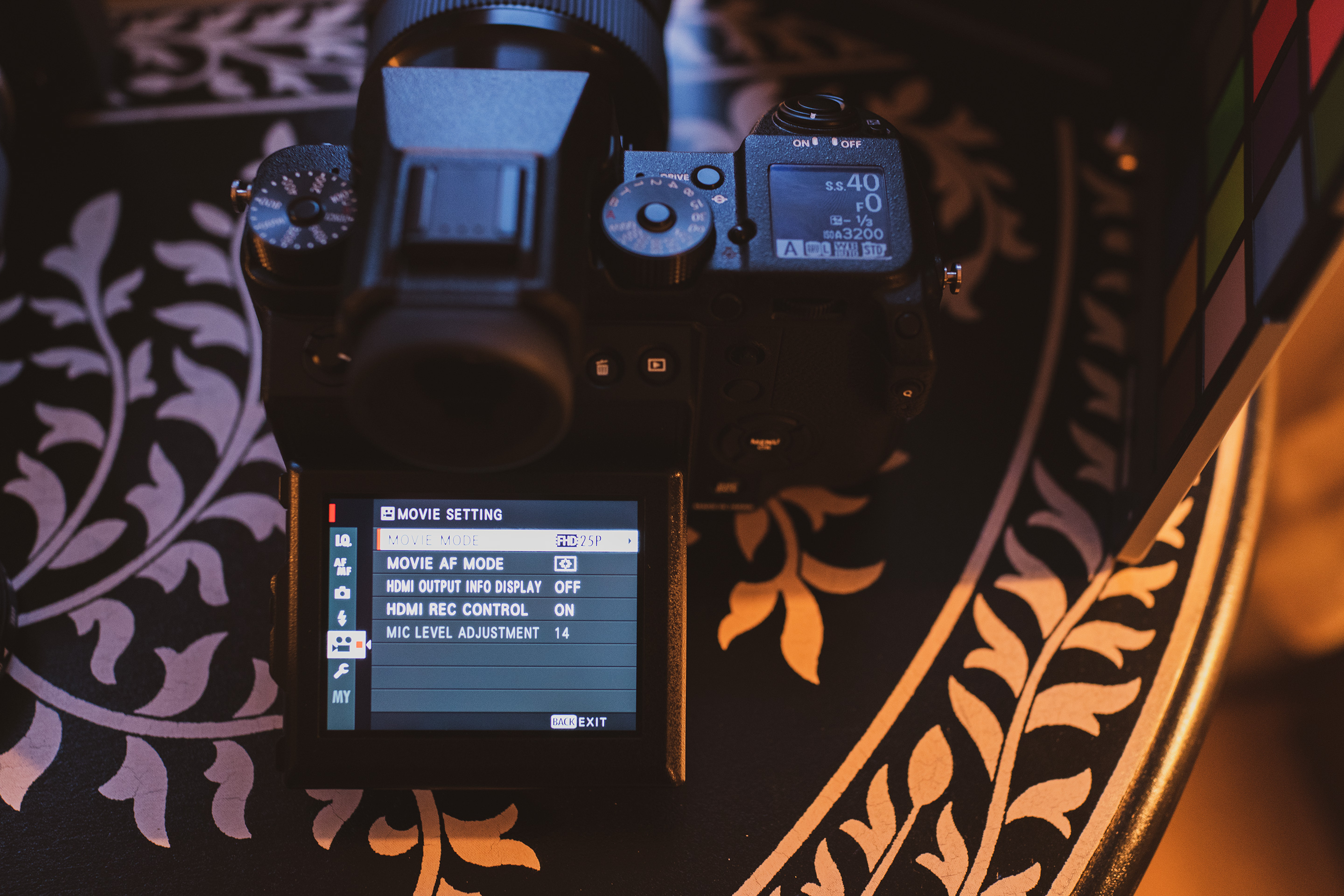
It’s flown under the radar for video but the Sony 100 megapixel CMOS sensor is doing amazing things over in the Hasselblad camp – 4K RAW to be exact. You can see a great video of that below but first – I present to you the humble Fujifilm GFX 50S.
If I told you Fujifilm had a full frame mirrorless camera system to compete with the Sony A7R III, a lot of people would sit up and notice. However the GFX 50S is a medium format camera, and these don’t really register on the same radar screen as others.
The X-series only started in 2012 but in the 6 years since (an incredibly short time relative to other manufacturers) Fujifilm not only have given us what is arguably the best APS-C camera available with the X-H1 but and the best pro photographer’s full frame mirrorless camera. Hang on, isn’t the GFX 50S medium format, not full frame? It’s both. The latest firmware update adds a full frame crop mode in much the same way the A7R III has a Super 35mm crop mode. Strange to think of full frame as a crop but it is on this camera with the enormous sensor. So in this mode you can have full compatibility with a huge range of full frame lenses, DSLR stuff, Canon EF with autofocus via the Techart adapter and Leica M lenses on a medium format sensor (oh my). So I will be reviewing this camera not just as a medium format camera like the Hasselblad X1D or Pentax 645Z… It’s more than that, it’s a full frame mirrorless camera and medium format rolled into one and the only camera to take on Sony’s A7 range if you exclude the Leica SL.
With the crop from 50 megapixel medium format sensor to full frame you end up with 30 megapixel images. You save a ton of money not buying medium format lenses though. They are expensive with a capital E.
Meanwhile on the video side, the quality of the 1080p is actually quite good, better than the 5D Mark III, but image processing is a bit too compressed. 36Mbit only. This is crying out for a firmware update for 2K Cinema DNG RAW to UHS-II card. That can be achieved with or without compression, as the GFX 50S features not one but two very fast UHS-II speed slots. Even better would be 4K raw, from a pixel binned output (an 8K readout is not here yet) or a cropped region of the sensor.
Firmware updates are a huge Fujifilm strength (and long may it continue).
Let’s see what they do.
Here’s what the Hasselblad H6D 100C is capable of with 4K RAW:
Medium format Noctilux F1
Even better than enabling the 35mm full frame crop mode, is that some full frame lenses actually cover the full 44 x 33 medium format sensor without vignetting. Many you would not expect to. This blog post by photographer Jonas Rask reveals the cheap Minolta Rokkors to be particularly good, with magical results.
Personally I am enjoying the Sigma ART lenses the most. The 24-35mm F2 and 85mm F1.4 are nuts with this camera.
You can also choose to shoot stills in a square 1:1 aspect ratio with full frame lenses on the GFX as the vertical size of the sensor is 33mm – similar to the horizontal width of a full frame sensor (36mm) which the image circle projected by a full frame lens has to cover. So full frame lenses have an image circle diameter of at least 36mm… Some have a larger ones. Those are over-engineered for coverage to improve corner sharpness.
So with the GFX sensor, you can think of it as 33x33mm square, traditional 3:2 full frame 36x24mm or epic 44 x 33 medium format (4:3 aspect ratio).
Already some good used deals can be had on the GFX 50S body. Also factor in that you can spend £50 on a Rokkor rather than £3000+ for modern medium format lenses for other systems. At London Camera Exchange in the UK, effectively my GFX body cost £3700 after taking out the value of the bundled Fuji lens that came with it, so not much more than a new Sony A7R III body-only. Yes, this is still expensive but the average used price of this camera body-only in a year I think will be within £1000 of the Sony for a lot more power.
Some of the lens adapters for the GFX 50S are far more expensive than for other systems and to get around this I devised a devious ploy.
- Buy a single GFX to Leica M mount adapter (Fotodiox Pro, £130)
- Buy 6 adapters to Leica M mount at £20 each on Amazon (Nikon, Contax Zeiss, Canon FD, M42, Minolta MD, passive EF mount)
Here it is with my Leica M mount adapter + second adapter to Nikon G…
Infinity focus is no problem and it’s a firm lock-in. The Leica M adapter is very shallow so effectively feels as if you are putting the lenses straight onto the GFX body, not on a tube sticking out.
The Leica Noctilux 50mm F1 can be used on medium format for the first time… And since the larger sensor is a 0.79x crop on full frame you end up with a 39mm F0.79 equiv., very close to the look Kubrick was getting with his famed NASA lenses.
The Noctilux does vignette though (at least my old F1 version does, not tried the new F0.95) and some DSLR lenses cover completely, like the Nikon 58mm F1.4G… a light and a modern lens which is over-engineered to ensure sharp corners on full frame – so the image circle is larger than necessary.
Here’s the Noctilux shot wide open at F1 on full frame (Sony A7 III) – even on the intended sensor size it has a dramatic fall-off in the corners, which gets even darker with a high contrast grade like this (but it’s all part of the appeal) –
Here is the Noctilux on medium format with the GFX 50S for the first time ever. Weird, but I love it.
And here’s the Nikon 58mm F1.4G – ZERO vignetting in the corners although the bokeh starts to warp like the Noctilux:
There’s also an autofocus adapter for Canon EF lenses (and by association Sigma ART).
Speaking of over-engineered, the Sigma ART 85mm F1.4 has full coverage on medium format and is just unbelievably beautiful – there’s no real medium format lens so bright wide open. I have this on a passive Leica M / EF adapter at the moment because I cannot seem to find the Techart EF adapter in the UK. That adapter has electronic aperture control and image stabilisation compatibility, as well as AF. Hopefully I will review it before long.
The Sigma ART 24-35mm F2 also – very surprisingly – covers without vignetting. This is a full frame F2 zoom!! Try finding a 24-35mm F2 medium format lens let alone for £700. I haven’t done an extensive test of this lens yet on the camera for corner sharpness or distortion but it has quite a magical look on the few shots I’ve taken with it so far.
Sigma 85mm F1.4 ART:
Sigma 24-35m F2 ART:
Here’s a quick snap or two using the 24-35mm F2 (@ 35mm) in medium format mode (44 x 33mm):
Advantages of the larger sensor
Just as full frame has a ‘special’ look compared to smaller sensors (at least at identically fast apertures) so does medium format over full frame. The great advantage of medium format though is that you can maintain a very beautiful shallow depth of field without using such mushy wide apertures. You can stop down your adapted F1.4 DSLR lenses to F2.8 for higher resolving power and still enjoy the beautiful rendering and three dimensional depth of field of a very wide aperture on full frame.
That’s why actual medium format lenses start around F2.8 or F3.5 max – to deliver MUCH higher resolution than a full frame lens at F1.4 is the primary purpose of all medium format systems. The larger sensor can also support high resolutions with larger pixels, where a full frame sensor would begin to struggle with a small pixel pitch. This is to the benefit of dynamic range, under-exposure recovery and colour. These attributes coming from the 50 megapixel CMOS in the GFX 50S are the stuff of dreams (as Philip Bloom found out with his Pentax 645Z). I have never been happier with photo quality as I have been with this.
The GFX 50S combines punchy colour and high contrast ratios with a high dynamic range, just like film. Usually you can have wishy washy weird colour and high dynamic range, or a high contrast with nice colour but clipped dynamic range. This does both.
So until the GFX, full frame lenses on medium format just wasn’t possible, it was unheard of and so you are creating images that are possible only for the first time in photography.
A very important differentiating factor between the Fuji GFX 50S and the Hasselblad X1D is that it has a focal plane shutter in the body. You can’t adapt full frame lenses to the Hasselblad X1D at all as it relies on a traditional medium format leaf shutter in the Hasselblad lenses. That camera is just a sensor in a pretty body – and massively overpriced – compared to the GFX in my opinion. A leaf shutter in a lens tops out around 1/800 with all but a few exceptions, whereas the focal plane shutter on the GFX goes to 1/4000. It even has a silent electronic shutter which goes to 1/16000. Before this medium format cameras required ND filters or slow apertures when shot with in bright light.
What about the rest? You get 50 very fat megapixels vs 42MP on a Sony and 24MP in the Leica camp. There aren’t any other mirrorless cameras that compete on sensor size. Canon, Nikon, Panasonic and Olympus haven’t got a full frame mirrorless camera out yet let alone a medium format one. Imagine a full frame X-T3 – that would set the world on fire but Fujifilm are playing the long game with the GFX instead. And here’s why…
I can see a point where you and me get bored of full frame and want a larger sensor. If a larger sensor than full frame ever goes head-to-head on price, Fujifilm will be the best placed to deliver. They have been in this game for longer than we think. It’s not just their mirrorless technologies… Fujifilm have been making the HC lenses for Hasselblad for years and their optics for the GFX system are nothing short of Hasselblad quality. That is to say $6000 quality for half the price… and half as bulky.
Areas of improvement
For your main video camera the X-H1 is the one to get but video is a nice bonus on the GFX 50S – however just to state the obvious, as a studio-type camera it has no in-body stabilisation and only two of the GFX lenses have OIS. You will need to use the smart Techart Canon EF adapter with a Canon IS lens for shooting steady handheld video.
The medium format look of the large sensor is noticeable, so that goes someway to compensating for 1080p – the audience might well notice the look of the lens more than they notice the extra detail of 4K – but the video codec isn’t Fuji’s best on this camera and the image processing is more on par with the X-Pro 2 than the new X-H1. I know the processor in the GFX likely can do 4K as we saw with the firmware update on the X-Pro 2 but can the gargantuan sensor? Maybe not, but since the 2K image is still better than the 5D Mark III on Canon’s stock firmware, a Magic Lantern style leap with RAW video would catapult quality into pro territory and it would be quite unique on the market, with only the $32,000 Hasselblad H6D-100C doing raw video on such a large medium format sensor.
The other area of improvement is to bring the quality of the internal video up a bit more for the benefit of live-view, because it can get a bit pixilated and noisy compared to the Leica SL and Sony A7R III, to the detriment of the VERY good EVF and LCD they put on this camera. That’s not to say it’s really bad – more that it could be even better. Fujifilm already have the answer to this because when you switch to video mode the detail level jumps up in the viewfinder and on the screen, without any crop aside from the black bars for 16:9. So if they can do such a nice live-view feed in movie mode why not in stills mode? If it is for energy saving then at least give us the option for a ‘boost mode’ in the menus! Let’s maximise the hardware with a cleaner live-view image.
With a faster sensor readout comes better contrast-detect autofocus as well. Maybe this is asking too much on a 50 megapixel medium format sensor, but if they could optimise the speed at which the sensor scans they could bring that benefit to the contrast detect AF system as well, which is just ‘ok’ and not at the snappy level of high-end Micro Four Thirds cameras.
I have no further substantial complaints about this almost perfect camera system. One thing I would request is for the full frame 35mm crop mode to be assignable to a function button for toggling on/off. That gives us two formats in one camera instantaneously during a shoot and even in-between shutter releases, but at the moment it is buried in the Mount Adapter Settings part of the main menus. Sure you can crop in post, but second-frame is nice to have during the moment with live-view… and also, they should try and make it work in video mode. At the moment video mode is medium format size only.
Handling and ergonomics
For photos, this thing is a dream.
If you have used a Hasselblad, that thing is a bloody big dream, very very heavy. My H3D-II has a HUGE optical viewfinder, the best you will ever see in your life and a wonderful modular design but it sucks in dust like an antique collector’s vacuum cleaner. Only recently have Hasselblads even got live-view. If you think Canon is stuck in the past, well the Pentax 645 and Hasselblad form factors haven’t changed in decades!
Of any mirrorless camera the GFX 50S has the chunkiest and most pro feel, yet immediately one feels at home as a Fuji shooter. It really isn’t meaningfully much bigger than other pro mirrorless cameras. Here it is next to the Fuji X-H1 and Sony A7 III –
I really like the lack of consumer-camera mode dial, with the twin shutter speed and ISO dials. The GFX lenses have a physical aperture ring, and the whole thing feels more like a camera than an A7R III, which feels like a Playstation controller.
The top-panel is an e-ink display, and this was the release that pioneered it ahead of the X-H1. Unlike the Hasselblad mirrorless medium format camera, the X1D – this has an articulated screen and even the EVF can go full-tilt with an adapter. Uniquely, it is detachable and hands-down the biggest EVF I’ve ever looked through.
Finally, common sense has hit home and the battery door is on the side of the camera instead of the base. You can swap that out without accessing the bottom of the camera on a tripod and of course it’s the same with the memory cards. The GFX takes a very large battery at 12v, which is nearly double the voltage of a DSLR battery. That gives you some idea of the impact such a large sensor has and the 16bit processing required for a high-end medium format camera. The battery compartment in the side rather than under the grip means the camera’s back sticks out further than I’d like but it’s only an aesthetic consideration, rather than any usability handicap. The shelf it creates between the back screen and the viewfinder, leaves room for a focus-mode selector, playback button and delete key. The drive-mode button is on the top of the camera but out of reach of your trigger finger, oddly. It’s about the only misplaced button on the camera and not one I’d use a lot with medium format because of the limited AF-C and slower burst rates. The only thing is, the video mode is tucked away as a drive mode again as Fuji is prone to doing even on the video focussed X-H1, so that’s not ideal and could do with being a function button toggle on/off.
A small touch but I like that the function buttons don’t have labels like “Fn1”. Makes the back panel look more minimalist and less cluttered.
This is a first generation product and similar to the gen-1 Fuji APS-C camera (X-Pro) the lenses seem to have external focussing parts, they grind on a big motor and there is no phase-detect AF yet. I am not sure why Fuji can’t fly out of the gates with internally focussing elements and phase-detect AF, presumably they want to give you a reason to upgrade later! However it is with manual focus that I’ll be using the camera most of the time with adapted lenses, as I can’t justify the expense of a whole bunch of GFX lenses after spending so much on the camera body. I have other cameras for capturing tricky movement with very fast AF (Sony A7R III).
Conclusion
Be sure also to check out Julia Anna Ggospodarou’s review of the Fujifilm GFX 50S!
The Fujifilm GFX 50S offers better images than full frame, and that is saying a lot. Better ergonomics than Sony. Incredibly small and light for a medium format rig. Superb native lenses. Incredibly adaptable to other lenses – takes almost every lens and every situation you can throw at it. More versatile and feature packed than the cameras that share a similar sensor like the Hasselblad X1D and Pentax 645Z. Genuinely opens up new photos and rendering from your existing full frame lenses, never possible before, with F1.4 lenses becoming effectively F1.0 in terms of shallow depth of field and the sensor is a monster – 50 megapixels, HUGE dynamic range, at least 6 stops recovery for underexposure and close to 15 stops in total. It’s also a capable low-light performer unlike medium format cameras with CCD sensors. I can shoot at ISO 12,800 with ease and still bring an underexposure to life without too much noise. What grain there is looks incredibly filmic and the large resolution of the images further lower noise when you view prints at normal sizes or on the average display.
Yes I admit that I’ll be using the Fujifilm GFX 50S solely as a photography tool rather than pro video. It’s what it’s designed to do and it does it better than everything else on the market, with the exception of perhaps that 100 megapixel $30,000 Hasselblad. A medium format 100 megapixel sensor shooting 4K ProRes RAW internally is a sign of things to come. The next step after the current generation of Sony A7 cameras and 10bit Panasonic GH5. The Fujifilm GFX 50S is the here and now and the cheapest medium format mirrorless camera available.
In video terms it is a gem waiting to be unlocked with a opportune firmware update. Please Fujifilm give us that 2K RAW. If the X-Pro 2 can get 4K in a firmware update let’s see what pixel binning gets us on the GFX 50S sensor as well, when pushed to the maximum. The sensor already reads off a raw image for 1080p at 24fps into the buffer, then it’s just a case of the Fujifilm firmware writing that to a fast UHS-II SD card for us to process in post in Resolve.
View the complete GFX 50S specs at Fujifilm and expect a more in-depth review of the GFX 50S at EOSHD after my first impressions mature into a months worth of shooting with it.
UPDATE 1: Feedback for Fujifilm (which I have also sent directly)
- Please get camera to copy the 1080p video buffer to card for Cinema DNG raw video
- Have a boost mode for live-view in photo mode which matches more detailed live-view in video mode
- Add crop modes for video – full frame, Super 35mm and even 1:1 crop (with high resolution than 1080p in some modes if possible?)
- Make crop mode a quick-toggle assignable to function button
- Make video mode quick-toggle assignable to function button (not buried in Drive Mode menu)
- Further optimise contrast detect AF speed
- Pixel binned 4K like X-Pro 2 if possible?
UPDATE 2: Quick chat about the Hasselblad H6D 100C with the creator of this video Matt(e) Production –
– The full width of the sensor is used with top and bottom cropped to give 12K 16:9 video down sampled to 4K in camera– This results in beautiful images AND lots of rolling shutter. Kinda like the a6300 and a6500. No handheld shooting here.
– The body has no fans. It has passive cooling and may overheat if left in live view mode for video shooting for extended periods.– It eats a fair bit of power for video, so you need to use an external power source to augment the hand grip battery.– The shadows can have a strange noise pattern in some situations. You can see this if you look hard at some of the shots with deep shadows in the video.




